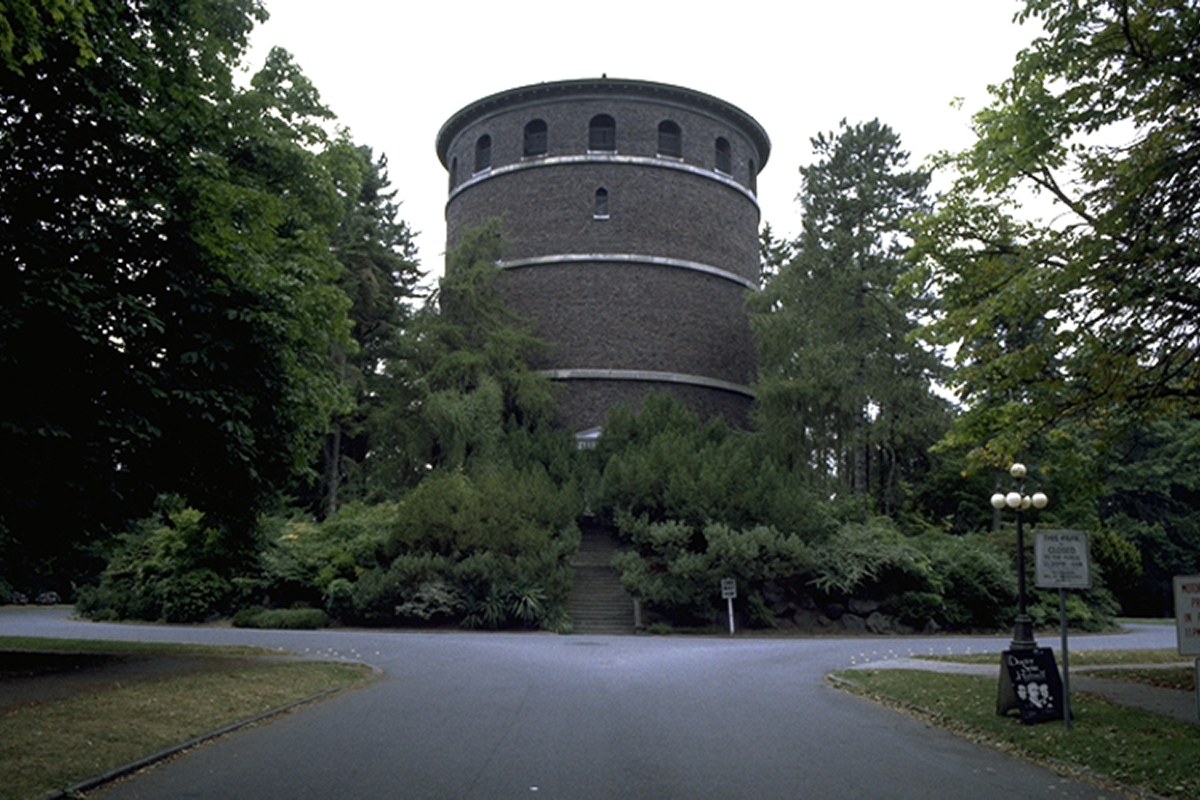Aqua Pura Vista
Video, Light, Sound, Plexiglas Installation
H 88' Diameter 60'
The Water Tower, Volunteer Park
Seattle, Washington
March 21 - April 24 2000
Acknowledgements
Seattle Arts Commission
King County Arts Commission
Seattle Public Utilities
Department of Parks and Recreation
Puffin Foundation
Bellevue Art Museum
Pacific Northwest Ballet
Jack Balduf
Rico Chiarelli
Tim Coulter
Martin Dilks
Bonnie Duncan
Lisa Hudson
Peter Gantt
Paul Gillis
Roddy Grant
Marietta Millet
Kerstin Mueller
Jason Nejezchleb
Cristine Reynolds
Mark Sell
David Whitfield
Uldis Zarins
Nadeem Nazim
Special Thanks
Howard T. Howlett
Howard Meeks
Project Archive
Press
Aqua Pura Vista
Summary
The exhibition mimics the arches' sun patterns using video and light projections onto the surface of a cylindrical projection screen. Images and sound dealing with water resonate with the tower itself, which is a container of water. Gradually the dynamic quality of nature emerging from the arches of the tower meet with the kinetic performance of the installation and the experience becomes one.
Project Description
Ascending the spiral stairs to the observation deck, the visitor is enticed by the promise of a panoramic view. The 360-degree view of Seattle is, however, punctured by each of the sixteen arched windows of the observation deck. Instead of panoptic mastery, there is a fractured vision of places and objects both recognized and obscured. Vegetation and buildings overlap one onto the other; our memory or knowledge of Seattle's topography struggles with our perception and desire to reconstitute the incomplete vista – to use memory and sensation to complete an image of the city with our inner eye.
The viewer turns from the exterior to the interior, and sees a simulacrum of the arched observation deck in arch-shaped projections of natural light onto the observation deck of the tower. The sound of dripping water emanates from the gates of the tower up to the observation deck. From here one can see two concentric projection screens, hanging from the roof structure and circumscribed by an existing chain link fence that protects the lid of the water tank below. Multiple layers of translucent plastic wrap added to the chain link fence have an illusory effect that causes the eyes to perceive the installation inside as nebulous, not distinct. The installation's inner screen has eight arched cutouts that mimic the ones of the tower; the outer screen is plain. Within the circular projection screens, video and light projectors hanging from the rear of the ceiling project images onto the inner screen and through the arches to the outer screen. The nature of the screen material is such that arches fade in and out as the viewer moves around and watches a multitude of arches overlapping onto each other.
Hence the deceiving dialectical nature of the installation, where the inside mimics the outside and, by means of the two sets of arches both real and virtual, passes the viewer's gaze from the essentially incomplete panorama on Seattle to the jarring images of the installation. Sun light, video and light projections of arches alternate with one another and overlap before the eyes of the visitor. Video projections framed in the shape of arches unfold stories of bodies submerged in the water, showing oversized images of hands, faces and arms slowly moving and floating. The activity of the eye thus engages both mind and body in a certain struggle to decipher, to find signs and to recognize incomplete images of hands and faces otherwise individually disconnected within the arches.
But the repetitive forms and the circular movement lead to synthesis and resonance as well as discordance, entrancing the eye, which looks simultaneously at and through the video and light projections mingled with images of Seattle's panorama. Video, light and sound projections intimate memories and sensations of a timeless life, randomly measured by the sound of dripping water and vocal chants reverberating from the observation deck into the spiral stairs, and back to the observation deck. Themes dealing with water begin to symbolize the tower itself, which is a container of water, and gradually the perception of the space and that of the installation, a positive projection of the tower, become one.
" . . . Whereas the Tower overlooks not nature but the city; and yet, by its very position of a visited outlook, the Tower makes the city into a kind of nature. To visit the Tower, then is to enter into contact not with a historical Sacred, as in the case of the majority of monuments, but rather with a new nature, that of human space: the Tower is not a trace, a souvenir, in short a culture, but rather an immediate consumption of a humanity made natural by that glance which transforms it into space".




